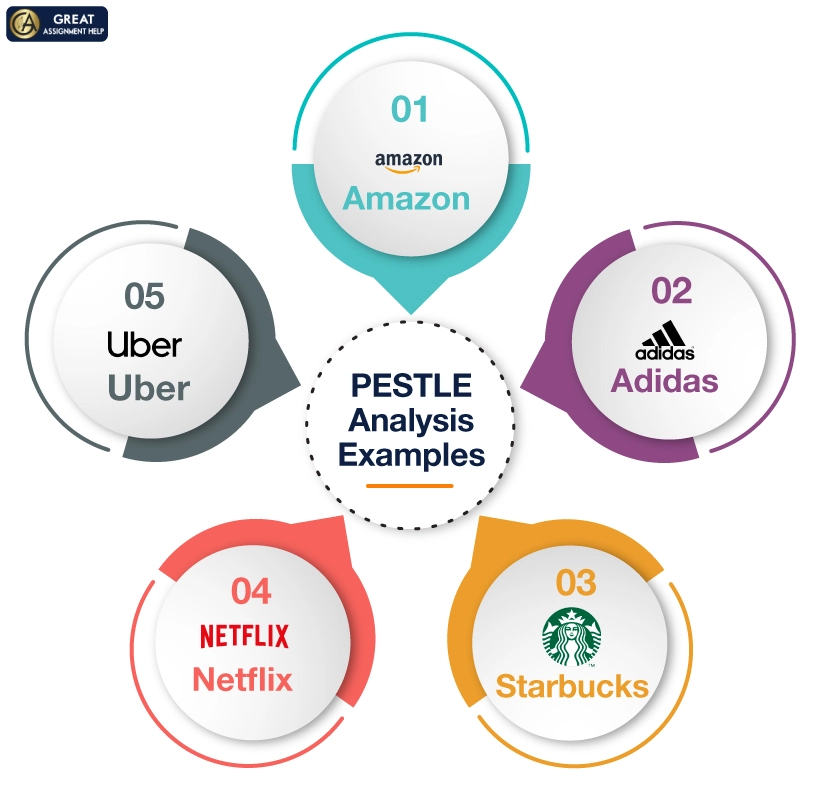Table of Contents
Are you a management student who wishes to learn about PESTLE analysis? Do you want to write a PESTLE analysis case study of any multinational company? To help you, here we have shared the basics of PESTLE analysis. However, you can’t gain deep knowledge with a general definition. So, for a better understanding of the concept, along with the definition, we have also composed a list of a few real-time PESTLE analysis examples in detail. Continue reading this blog post and explore the PESTLE analysis examples of real-time businesses.
What is PESTLE analysis?
PESTLE analysis or PEST analysis is a significant marketing concept that is used to analyze the Political, Economic, Social, Technological, Legal and Environment factors that affect an organization. Mainly, the business organizations perform PESTLE analysis before they launch their new product, project or service. Also, the companies conduct PEST analysis to track their operational environment.
The PESTLE analysis is a comprehensive version of SWOT analysis. Often, the entrepreneurs and companies conduct PESTLE analysis to make suitable decisions, determine the future scope of action and build measures for strategic management.
Till now, we saw the basic definition of PESTLE analysis. Next, let us learn how to do PESTLE analysis by looking at certain real-time PEST analysis examples.
The Best Real-Time PESTLE Analysis Example

Here, to explain the analysis process, we have selected 5 top companies of different niches and have conducted the PESTLE analysis.
The PESTLE analysis case studies of companies that are covered in this blog post are
- Amazon
- Adidas
- Starbucks
- Netflix
- Uber
Go through the PESTLE analysis example of each company and gain a complete understanding of the concept.
PESTLE Analysis Example: Amazon
Amazon is a multinational company based out of America. The company exclusively focuses on e-commerce, digital streaming, artificial intelligence and cloud computing. Despite having a fixed spot in the global market, Amazon competes with many tough competitors in the market.
Now, by doing the PESTLE analysis of Amazon, let us see the drawbacks and other external factors that affect the overall performance of the company.
Political Factors
- The government’s cybersecurity rules and the hassle-free e-commerce operations stand in favor of Amazon’s business.
- The company has strong knowledge of government intervention and its business growth opportunities in the industry.
- The encouragement from the government helps Amazon’s online retail business to gain popularity. But, the company still faces a risk in the retail field because of heavy competition from other top popular online retail brands.
Economics Factors
- The tax regulation in Asian countries is the constant challenge regularly encountered by Amazon.
- The economic stability of the company has wide growth opportunities in developing countries.
- Amazon’s offers are one of the attractive features enjoyed by the customers. Even people who don’t look for expensive items get benefits from it.
Social Factors
- Amazon relies more on technology than employees. If this trend continues, then the job opportunities will get reduced and which in turn may cause a social threat for the company.
- Consumerism has increased exponentially because of the growth in online shopping. The major reason for Amazon’s popularity is the easy availability and delivery of products to people of all age groups at their doorsteps.
Technological Factors
- In order to reach customers quickly, Amazon tries various creative and innovative ways. Still, they are searching for new shipping methods for the fast delivery of products.
- It is easy for the customers to access all the Amazon services through websites and mobile applications.
- To connect easily with the customers and resolve their queries, Amazon has a live chat option. Also, the company has decided to hire more people to offer customer service. By utilizing the advancement in technology, the company works to provide a better experience to their customers.
Legal Factors
- Amazon is offering its services in many countries across the globe. But, it only works as per the legal rules and regulations of the country they offer their services in.
- The company has strengthened its brand image by following environmental protection regulations. Apart from that, the company also experiences some challenges from its competitors because of its alterations in the import and export policies.
Environment Factors
- The company is highly-interested in environmental programs.
- The company has enhanced its growth opportunities by expressing its interest in promoting business sustainability, low-carbon lifestyle, and waste management strategies.
From this PESTLE analysis of Amazon, the authority of the brand in the industry is visibly clear. The company can still continue to stand in the top place of the online retail market if it concentrates on the external factors that affect the overall performance.
PESTLE Analysis Example: Adidas
One popular multinational company that is known for the supply of shoes and apparel is Adidas. It is a German-based company that is currently ruling the sports apparel market. The company survives in the industry at the top after regularly tackling all the challenges that exist in the industry.
Here, let us have a quick look at the PESTLE analysis of Adidas and learn about the overall performance of the company and the factors affecting it.
Political Factors
- Adidas is one of the very few companies that move forward even after facing huge political changes, serious risks, and civil turmoil.
- In its operational countries, the company was affected badly by the taxation system.
- The company’s entire work and the delivery of products were also affected by other political factors such as war, national movements, terrorism, etc.
Economics Factors
- Because of the fluctuations and instability in the global market, the company’s progression rate and advancement were affected.
- Adidas has suffered from continuous failures and a downfall in the economy till 2005.
- Taxation, Inflation, Unemployment and per capita income are other economic elements that have degraded the profit generation in the company.
Social Factors
- The potential customers of Adidas are health-conscious people and athletes. Hence, due to the purchase preference, a great impact is created on the profit of the company.
- In Islamic countries, Adidas finds it difficult to step in and survive. So, to solve this issue, the company has to develop a strategy relevant to the Islamic culture and promote its products.
- One attractive feature of Adidas is that it manufactures all of its products matching the current trends irrespective of religion, age and gender. Hence, all types of customers in society prefer to use the products of Adidas.
Technological Factors
- To be successful in the industry, Adidas should depend more on the latest and modern technology.
- The online marketing strategy of Adidas is powerful and hence the brand has customers from all over the world.
- To create a unique identity for the brand in the market, Adidas always prefers to move ahead of its competitors and thus invest more in the company’s research and development activities.
Legal Factors
- Because of the reputation and the brand value of Adidas, the trust of the customers on the global level is retained.
- As the company is operating in various countries across the globe, the management should have strong knowledge of taxation methodologies, restrictions and domestic law of each operational country.
Environment Factors
- Adidas has claimed that they adhere to an industrial process that is harmless to the ecology and nature.
- No restricted products are manufactured by Adidas.
- To check the emission of volatile and organic compounds that are harmful to the environment, Adidas uses modern technologies.
- The brand image of the company is enhanced because of its attitude towards environmental protection.
This PESTLE analysis shows the reputation of Adidas in the international market. But to withstand on the top level in the field, the company has to cross more milestones, set high objectives and visit new things in their territory.
PESTLE Analysis Example: Starbucks
Starbucks is one of the biggest multinational chains of coffeehouses that have its headquarters in Seattle, Washington. It is operating in various countries in the world. In particular, regarding the coffee culture in the world, Starbucks represents the entire USA. Even though Starbucks is popular, it also suffers from certain external factors.
Now, let us focus in detail on the PESTLE analysis of Starbucks
Political Factors
- As per the recent trend of regional integration with external factors, during the global expansion of the company, several countries had bureaucratic red tape that made the business expansion of the company more difficult.
- During the Brexit event, the entire growth of the company was seriously affected because of the 60% reduction in the corporation tax of the US coffee chain.
Economics Factors
- Due to the recession of the present global economy, the profit of Starbucks scaled down. Hence, the customers have been given cheaper products for consumption.
- The company’s profitability also suffers because of the inflation in the operational cost and the labor cost.
- Taxation level, currency exchange rate in the local market, and the economic environment of different local markets are the other serious economic factors that affect Starbucks.
Social Factors
- The environmental and social costs also upset the brand because of the green and ethical chic aspects.
- The greatest challenge in the socio-culture of Starbucks is that by offering cheaper products to the customers, the authorities have sacrificed the product quality of Starbucks.
- When socio-culture is considered, the other factors that created an impact on the brand are the changes in lifestyle, work pattern, values, family pattern and customer preference.
Technological Factors
- Starbucks joined hands with Apple for technology-based services. Mainly, to attract customers through digital applications, the company offers discount coupons for the customers who place orders through Starbucks apps from Apple and mobile phones.
- In recent times, internet services are more important. Hence, Starbucks in their outlets provides Wi-Fi facilities for their customers.
- To pay bills easily through digital mode, the company has also enabled mobile payment.
- For providing top-quality coffee to its customers, Starbucks concentrates more on agriculture, biotechnology and other innovative technologies.
Legal Factors
- Starbucks is required to follow the rules and legal regulations of its home country, operational countries and the countries from which they purchase raw materials.
- The health authorities also have regulations and policies regarding the consumption of Starbucks’ caffeine products.
- With respect to maintenance, Starbucks should stick to the health authority guidelines.
- Trade regulation in their operational countries and the licensing regulations from the appropriate industry are the other legal factors Starbucks should consider.
Environment Factors
- The environmental disaster that arises during coffee harvesting is one of the serious environmental threats that might affect the company.
- Another environmental issue that impacts the brand at the world level is Global Warming.
- The company manages all the environmental issues and their impacts by adhering to the environmental guidelines.
On the international level, Starbucks is popular for its top-quality products. This American Multinational Coffee chain has a set of unique customers, and it may also create an effect on the lower and middle-tier customers of the society. Starbucks will continue to be the leading brand in its industry if the external factors that affect the business are handled effectively.
PESTLE Analysis Example: Netflix
Netflix is a famous over-the-top (OTT) platform that is offering its service in many countries across the world. This streaming company has its headquarters in Las Gatos, Unites States. Nowadays, more than the cinema halls, people prefer OTT platforms like Netflix to binge-watch TV shows, web series and movies at the weekend.
Here, let us have a look at the PESTLE analysis of Netflix and explore the factors that affect the performance of the content streaming platform.
Political Factors
- The one major issue Netflix face is censorship. Because of the content it streams, Netflix is prohibited in the biggest economy country like China.
- Netflix faces a loss in certain operational countries because of government rules and policies. In some countries, the entire content of Netflix is not available to view for the customers.
- In recent internet times, a large set of audiences have shifted to Netflix from the traditional TV and hence a few telecom giants in some countries have raised the internet rate which in turn causes a threat to Netflix’s business model.
- In many operational countries, Netflix is restricted because of government norms.
- In some countries, Netflix’s streaming service is taxed similar to the traditional media.
Economics Factors
- Due to the fluctuation in the exchange rate when buying other production companies’ content, Netflix’s economy gets affected. But the company still survives to earn profit from its original content like movies, web series and TV shows.
- The loyal customers of Netflix consider the hike in the subscription price as a serious concern. In general, the viewers will be satisfied only if the streaming platform offers high-quality content that is worth the money.
- Currently, many streaming platforms have grown up. Hence, Netflix faces heavy competition with their rivals because of the quality content that is being produced and released by the other streaming service providers.
- Due to content piracy, the profit of Netflix is also affected.
Social Factors
- Netflix’s friendly work environment improves overall productivity.
- The generosity of Netflix has attracted a lot of people because they contribute 2% of their total annual income for the support of black lives and the students from low-income families.
- Netflix is known for its flexibility. It always works based on the latest trends by encouraging the viewers to watch the live-streaming on mobile,
Technological Factors
- With minimal data, the users can view a high-quality video on Netflix.
- With a set of algorithms, Netflix uses a content rating system.
- Netflix uses Hermes, the automatic translating software for language translation.
Legal Factors
- A conflict is raised with the customers due to the sudden increase in the subscription price. Customers who were dissatisfied with the price regulations have also taken legal action against the company.
- Copyright is another serious issue Netflix frequently faces. To resolve this issue, the company should find a suitable strategy instead of blocking other country users.
Environment Factors
- Recently, Netflix has signed a partnership with EPA and has expressed its willingness to jump to renewable energy.
- Netflix reduced the use of paper in their office, for a sustainable future.
- As the service is completely online, Netflix doesn’t create more impact on the environment. But it consumes a lot of electricity.
Netflix has its services in nearly 190 countries with more than 195 million customers. The company is affected mainly by the remote macro-environment factors. With this PESTLE analysis, Netflix can identify its potential growth. Also, it can attract a lot of viewers and generate more profit by rectifying all the shortcomings that are caused by external factors.
PESTLE Analysis Example: Uber
Uber is a top company that is offering its taxi services in the majority of the countries in the world. With its easy accessibility feature and tax sharing facility, the company has earned a lot of customers. Uber has not only faced exponential growth but also has earned the outrage of its customers.
Political Factors
- As Uber has not made any clear regulations, it has been a part of many controversies.
- Regarding the insurance policy, an ambiguity exists between the users. In specific, when an accident occurs during the ride of a customer, the company is not in the position to provide a valid answer on who is accountable, the driver or the company.
- Uber fails to follow the domestic law of its operational countries. Hence, many Asian countries are in the plan to ban the company.
- In certain countries, Uber is under heavy scrutiny by government officials.
Economics Factors
- Uber works by sharing physical and intellectual resources.
- When compared to other private taxi services, Uber’s taxi service is cheap and easy to avail. The customers can use the Uber apps on their phones to quickly book a taxi to their desired destination.
- From the time of its establishment, Uber is growing rapidly beyond the expectation of the economic experts. As theUber taxi faces more competition, it results in the ban of their services in some countries.
- Uber has seen many customers when compared to other taxi services.
- In some countries, many people reach out to Uber for new job opportunities. But it was not evident whether Uber provides employment or takes away people’s employment opportunities.
- Uber focuses to provide the best service to its customers because of the name they have earned amongst the customers.
Social Factors
- The Uber mobile application is easy for customers to use.
- By providing the pick-up and drop location, the customers can easily get in contact with the drivers.
- The company offers premium services at a cheaper rate. Hence, customers across the world are satisfied with Uber.
Technological Factors
- Uber has invested a lot to conduct research and update the technology for the benefit of customers.
- For promotional activities, Uber uses social media and electronic media.
- The Uber mobile app is technically advanced. Using the Uber app, the customers can estimate weather, trip charge and traffic conditions.
- Also, the Uber app is customer-friendly and using it the customers can pay for the ride digitally through non-cash methods.
Legal Factors
- Due to a lot of unpredicted reasons, Uber is currently suffering from many legal problems.
- The company should stay alert in adapting the labor laws, employee safety rules and domestic laws in the field of technology.
Environment Factors
- No study is conducted on the environmental impact created by Uber.
- There is speculation that Uber plays a negative role in traffic and fuel consumption.
- Also, there is an active argument that Uber is causing traffic congestion and discouraging the use of public transportation among people.
The business growth of Uber was affected by several controversies. But, to survive in the field, the company has to resolve all the issues they face in various countries and update their service as per the current trend and modern-day needs of the customers.
Final Thoughts
We hope you are now clear with how to do the PESTLE analysis. Similar to the PESTLE analysis example shared here, you can also write a PESTLE analysis case study of any business or multinational company. In general, during PESTLE analysis, you should research a lot about the business and gather all the factors that affect the business. It is a time-consuming process that requires a lot of analytical skills.
If you are still vague about the PESTLE analysis concept or don’t know how to write a PESTLE analysis case study assignment, reach out to us for help. We have a team of well-experienced case study helpers to assist you in writing PESTLE analysis for both small and large businesses. Based on your requirements, we will deliver a high-quality assignment on time at a cheaper price. Just submit the order form and get an instant assignment helper from us with 24/7 customer support.



